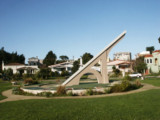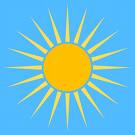 |
Sundial that shows clock time
Sundial Accuracy |
 |
| Most sundials show sun time, which varies from clock time plus or minus 15 minutes over the course of a year. Here's a sundial from the 1911 Scientific American that was designed to show clock time. |

This 1911 Scientific American article describes a sundial that was claimed to give correct standard clock time to the minute.
The exact location of this sundial is not given, and I don't find that it still exists.
There is an apparent error in this article. In the first column, second paragraph, it says "The dial of the instrument is tilted according to the latitude, so that it will lie parallel to the plane of the celestial equator."..."the dial face (is) tipped to the latitude of New York (which is about 41 degrees)."..."the face of the dial is parallel with the celestial equator".
Horizontal sundials have their gnomons tilted to the latitude of their location. But that results in the gnomon, or the dial of the sundial in this Scientific American article, being parallel to the earth's axis, not to the equator or to the celestial equator as this article states.

Robert Karis www.sfog.us |
Ingleside Terraces Sundial links:
Google map, directions to the Sundial Ingleside Terraces Sundial, Then and Now Photos Ingleside Terraces Giant Sundial Kite Aerial Photographs Sundial History |
Alphabetical index
Extreme sundials Geographic north Ingleside Terraces Sundial Sundial accuracy Sundial Bridge accuracy Sundial factoids Sundial plaques Sundials EOT tables Winter solstice | |
| The North American Sundial Society has a registry of over one thousand sundials in North America, including the Ingleside Terraces Sundial, which is number 82. | |||
| -------------------------------------------------- | |||